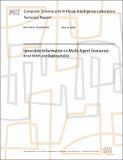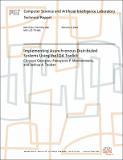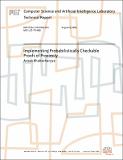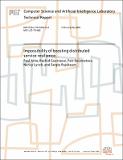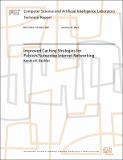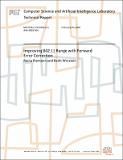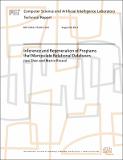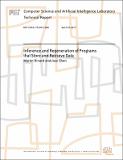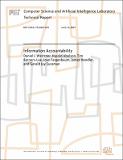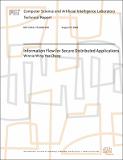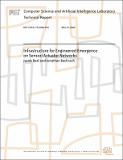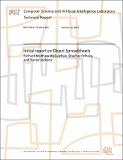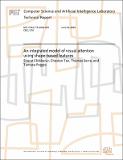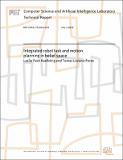Browsing CSAIL Technical Reports (July 1, 2003 - present) by Title
Now showing items 332-351 of 775
-
iBCM: Interactive Bayesian Case Model Empowering Humans via Intuitive Interaction
(2015-04-01)Clustering methods optimize the partitioning of data points with respect to an internal metric, such as likelihood, in order to approximate the goodness of clustering. However, this internal metric does not necessarily ... -
Identifying Expression Fingerprints using Linguistic Information
(2005-11-18)This thesis presents a technology to complement taxation-based policy proposals aimed at addressing the digital copyright problem. Theapproach presented facilitates identification of intellectual propertyusing expression ... -
Ignorable Information in Multi-Agent Scenarios
(2008-05-12)In some multi-agent scenarios, identifying observations that an agent can safely ignore reduces exponentially the size of the agent's strategy space and hence the time required to find a Nash equilibrium. We consider games ... -
iJam: Jamming Oneself for Secure Wireless Communication
(2010-06-07)Wireless is inherently less secure than wired networks because of its broadcast nature. Attacks that simply snoop on the wireless medium successfully defeat the security of even 802.11 networks using the most recent security ... -
Implementing Asynchronous Distributed Systems Using the IOA Toolkit
(2004-10-06)This document is a report about the capabilities and performance of the IOA Toolkit, and in particularthe tools that provide support for implementing and running distributed systems (checker,composer, code generator). The ... -
Implementing Atomic Data through Indirect Learning in Dynamic Network
(2006-10-12)Developing middleware services for dynamic distributed systems, e.g., ad-hoc networks, is a challenging task given that suchservices must deal with communicating devices that may join and leave the system, and fail or ... -
Implementing Probabilistically Checkable Proofs of Proximity
(2005-08-08)Abstract: In this paper, we describe a proof-of-concept implementation of the probabilistically checkable proof of proximity (PCPP) system described by Ben-Sasson and Sudan in \\cite{bs05}. In particular, we implement a ... -
Impossibility of boosting distributed service resilience
(2005-02-25)We prove two theorems saying that no distributed system in whichprocesses coordinate using reliable registers and f-resilient servicescan solve the consensus problem in the presence of f+1 undetectableprocess stopping ... -
Improved Caching Strategies for Publish/Subscribe Internet Networking
(2015-01-31)The systemic structure of TCP/IP is outdated; a new scheme for data transportation is needed in order to make the internet more adaptive to modern demands of mobility, information-driven demand, ever-increasing quantity ... -
Improving 802.11 Range with Forward Error Correction
(2005-02-24)The ISO/IEC 8802-11:1999(E) specification uses a 32-bit CRC for error detection and whole-packet retransmissions for recovery. In long-distance orhigh-interference links where the probability of a bit error is high,this ... -
Inference and Regeneration of Programs that Manipulate Relational Databases
(2017-08-29)We present a new technique that infers models of programs that manipulate relational databases. This technique generates test databases and input commands, runs the program, then observes the resulting outputs and updated ... -
Inference and Regeneration of Programs that Store and Retrieve Data
(2017-04-24)As modern computation platforms become increasingly complex, their programming interfaces are increasingly difficult to use. This complexity is especially inappropriate given the relatively simple core functionality that ... -
Information Accountability
(2007-06-13)Ease of information flow is both the boon and the bane of large-scale, decentralized systems like the World Wide Web. For all the benefits and opportunities brought by the information revolution, with that same revolution ... -
Information Flow for Secure Distributed Applications
(2009-08-27)Private and confidential information is increasingly stored online and increasingly being exposed due to human errors as well as malicious attacks. Information leaks threaten confidentiality, lead to lawsuits, damage ... -
Information Slicing: Anonymity Using Unreliable Overlays
(2007-02-23)This paper proposes a new approach to anonymous communication called information slicing. Typically, anonymizers use onion routing, where a message is encrypted in layers with the public keys of the nodes along the path. ... -
Infrastructure for Engineered Emergence on Sensor/Actuator Networks
(2006-03)The ability to control emergent phenomena depends on decomposingthem into aspects susceptible to independent engineering. Forspatial self-managing systems, the amorphous-medium abstraction lets youseparate the systemÂ’s ... -
Initial report on Object Spreadsheets
(2016-01-12)There is a growing demand for data-driven web applications that help automate organizational and business processes of low to medium complexity by letting users view and update structured data in controlled ways. We present ... -
Instruction-Level Execution Migration
(2010-04-17)We introduce the Execution Migration Machine (EM²), a novel data-centric multicore memory system architecture based on computation migration. Unlike traditional distributed memory multicores, which rely on complex cache ... -
An integrated model of visual attention using shape-based features
(2009-06-20)Apart from helping shed some light on human perceptual mechanisms, modeling visual attention has important applications in computer vision. It has been shown to be useful in priming object detection, pruning interest points, ... -
Integrated robot task and motion planning in belief space
(2012-07-03)In this paper, we describe an integrated strategy for planning, perception, state-estimation and action in complex mobile manipulation domains. The strategy is based on planning in the belief space of probability distribution ...



